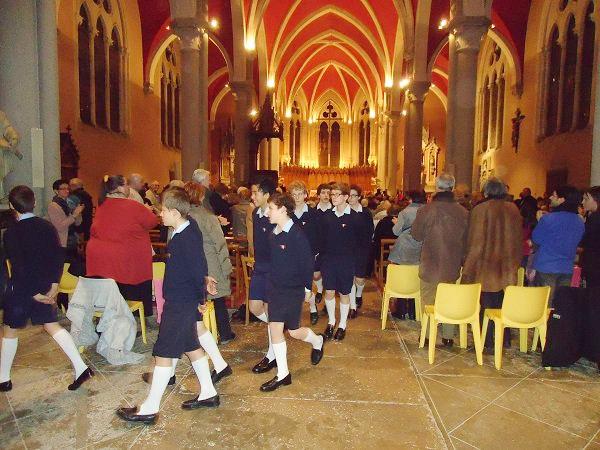
French Boy Choirs Performances: Hands

Figure 1.-- Here you can see the boys holding their hands behind their backs as they exit for the intermission. Notice how all the boys are doing this. A chorister tells us, "We usually we hold our hands behind our backs until after the choirmaster talks to us."
|
|
The French choristers boys are taught to keep their hands behind their backs. This is both in the procession and on stage. A chorister tells us, " It was a rule for us to place our hands behind our backs, not just only singing, but all the time." They keep their feet together, their shoes touching. Not only does it give a good impression, but it is a way to promote discipline and uniformity in the choir. The boys bow deeply at the end of the concerts. A reader writes, "Actually it is interesting how and why the choirs in France and Belgium make their boys put their hands behind their backs. Especially when the choirs are far apart geographically and not related, so it is not possible to arrange a common practice among all the choirs. If you have information to trace this tradition, it would be intneresting." We note a few choirs in other countries with this practice, but it is trye this practice is much more prevalent in Belgium and France than anyhere else. Surely it is primarily a way of giving the boys somethig to do with their hands. Otherwise each boy would do something different, fidgiting with their hands which would be distracting. We do not know, however, if this was a common practice for historic choirs. Our French contributor replies, "Yes, it is common for nervous fidgiting. For exemple you can watch an impressive Spanish choir. The boys there have been taught to hold their hands at their side which was the more common approch. You can see their nerves if you watch their hands closely. It is interesting why it seems only in France and Belgium that the boys commonly hold their hands behind their backs. A reader writes, "Although the Spanish soloist is fidgiting, he sings very well. I think he is very nervous which is understandable when doing a solo. The boys behind him, however, are fidgiting too much. You do not see these with the French and Belgian choirs because the boys hold their hands behind their backs. You do not see this with the choirs from othercountries." A factor here may be the French tradition of petits garçons modèles.
Another reader writes, "I think it could be a discipline practice like in the military." I think discipline is surely a factor. Once that become ingrained, the hands are one more factor you do not have to worry about and you can concentrate on the music."
A chorister tells us, "Yes, you are correct. At first it is not easy to maintain this position because it is tiring and as boys we like to fidgit, but after a while it has become ingrained."
HBC

Navigate the Historic Boys' Clothing Web Site:
[Introduction]
[Activities]
[Biographies]
[Chronology]
[Cloth and textiles]
[Clothing styles]
[Countries]
[Topics]
[Bibliographies]
[Contributions]
[FAQs]
[Glossaries]
[Images]
[Links]
[Registration]
[Tools]
[Boys' Clothing Home]
Navigate the Historic Boys' Clothing Web choir costume pages:
[Return to the Main French choir performance stagrcraft page]
[Return to the Main French choir performance page]
[Return to the Main French choir page]
[Return to the Main national choir page]
[Australia]
[Austria]
[Belgium]
[Bulgaria]
[Canada]
[Denmark]
[England]
[Finland]
[Germany]
[Japan]
[Netherlands]
[Poland]
[South Africa]
[United States]
Navigate the Historic Boys' Clothing Web style pages:
[Short pants suits]
[Blazers]
[Collars]
[Lace collars]
[Ruffled collars]
[Eton collar]
[Fauntleroy suits]
[Sailor suits]
[Ring bearer/page costumes]
[First Communion suits]
Created: 6:18 PM 2/11/2013
Last updated: 6:18 PM 2/11/2013



